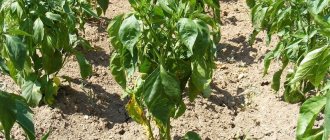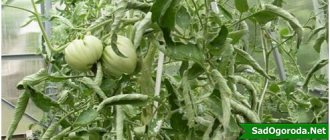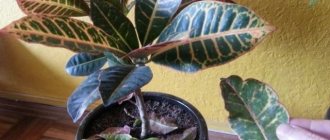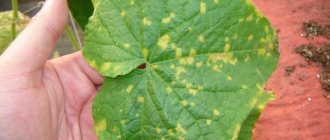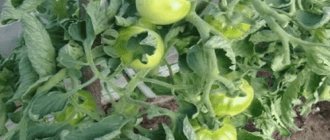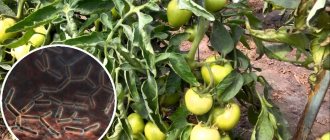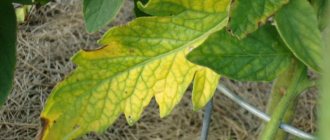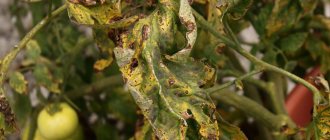Reasons for the appearance of white leaves on tomatoes in a greenhouse
Today, tomatoes are one of the most popular products that are always found on the table. Only sometimes it is quite difficult to grow them even in a greenhouse, since there are times when white spots may appear on the strongest and healthiest bushes. And not many gardeners know what causes this and how to deal with it. White leaves on tomatoes in a greenhouse - what could be causing this?
Reasons for the appearance of white leaves on tomatoes in a greenhouse
Brown spot
Not everyone, even professional gardeners, can say with confidence why the leaves of tomato seedlings turn white. There can be many reasons for this, and one of them is brown spot. Most often, tomatoes that grow in greenhouses suffer from this phenomenon. Symptoms of the disease:
How to fight
For preventive purposes, regularly ventilate the greenhouse.
The main reason why such a disease attacks the bush is the high percentage of moisture in the room and temperature. As a preventive measure, you can use constant and good ventilation.
If you just notice such signs on the bush, then you need to immediately treat it with Bordeaux mixture. This procedure must be done 4-5 times with an interval of 10 days.
Causes of white spots
Even though tomatoes are an “easy” crop, sometimes problems can arise with them, especially if they are grown in a greenhouse, although a greenhouse is a one hundred percent guarantee that the crop should definitely grow. But sometimes, due to the fact that there may be temperature changes and poor ventilation in the greenhouse, a number of problems may appear. Most often this happens due to the fact that they are exposed to the sun's rays, and were not previously prepared for this. Tomatoes have very tender leaves.
If these are sunburns, they usually only affect the upper leaves of the plant. In addition, this can happen due to the fact that the seedlings were not previously prepared for planting in the ground. Therefore, in order to avoid this, the first seedlings must be kept outside in the sun for at least several hours a day so that they get used to it. If this is not possible, then you can put them on the windowsill, where you can leave them for the whole day.
If you have not done this, then it is best to immediately cover them for the first time when planting, so that the sun does not hit the plant. During the first 11-15 days, the bushes will get used to the soil, and it is possible that they may not like it and then white mold may appear as a “protest” to the soil.
Powdery mildew
This disease first affects the leaves of the plant - they become stained, wither and fall off.
New leaf plates may grow in place of dormant buds, but they will no longer become full-fledged.
Powdery mildew is caused by fungal spores of the following species: Leveilluia taurica and Oidiopsis sicula.
Reasons for appearance
The fungus appears for several reasons:
- increased air humidity (more than 75%) at high temperatures (20 degrees and above);
- high levels of nitrogen content in the soil;
- densely planted seedlings;
- non-compliance with soil moisture regime.
The fungus can also be transmitted from an affected plant to a healthy one.
This happens in the following ways:
- by air;
- through water (splashes of water that break off when watering infected seedlings);
- the gardener himself transmits the fungus by touching a diseased sprout and then touching a healthy one;
- through parasitic insects.
Signs
Powdery mildew begins to attack the plant from the outside of the leaves. First, a slight pigmentation of small white dots appears (sometimes with a green or yellow tint). Gradually, the spots become larger and cover the entire surface of the leaf. As the disease progresses, the spots become whiter and denser - in the overall picture, the bush looks as if it had been doused with lime.
If you look closely, you can see that the pigmentation is covered with a tiny coating - this is the mycelium of the fungus.
Sometimes gardeners confuse powdery mildew with white spot. It is worth noting that the second disease develops from the inside of the leaf; first discolored and then reddish spots appear on its surface.
How does it develop and why is it dangerous?
Powdery mildew develops very quickly. At first, the fungus affects only small areas of the leaf blades. If no action is taken, the disease will spread to all leaves and cause them to fall off. However, often the affected leaves do not fall off. This is explained by the fact that powdery mildew lives on the plant as long as it shows at least some signs of life.
The danger is that the leaf blades of the seedlings begin to wither, turn yellow and may fall off. New leaves can grow in place of fallen leaves, but they often grow wrinkled and underdeveloped.
White plaque greatly affects photosynthesis, slowing down this process. If you do not start fighting powdery mildew, the seedlings will die.
Traditional methods
Such methods are most suitable for treating the disease in the early stages of its development. The most effective means:
- A solution of soda and soap. Method of preparation: dilute 50 g of soda and the same amount of laundry soap in 10 liters of warm water. Spray the seedlings with the prepared solution 2 times a week until the disease completely disappears. Try to get on both sides of the leaves. The plaque formed on the leaves of tomatoes will prevent the fungus from developing further.
- Serum treatment. It is diluted with water (1 liter of whey per 10 liters of water). The product is sprayed on seedlings 3-4 times with a break of 2-3 days. After treatment, a film will appear on the leaves, which will not allow the fungus to breathe, thereby leading to its death.
- Infusion of wood ash. Add 1 kg of ash to 10 liters of hot water. Leave to infuse for 7 days. After this, pour the solution into another container so that the ash remains in the first. The resulting solution is sprayed on tomatoes every other day until the fungus disappears.
Chemicals
Powdery mildew is killed by fungicides. Products must be prepared according to instructions.
During processing, it is also important to observe safety measures: wear protective clothing and, if possible, ventilate the room.
It is recommended to wear safety glasses to protect your eyes.
Effective drugs:
- "Topaz".
Dilute 2 ml per 10 liters of water, stir thoroughly. Treat the plant every two days. The treatment is carried out until the fungus is completely destroyed. The cost of the product is 40-50 rubles. - "Tiovit Jet".
For 10 liters of water you need to take 20-30 g of the drug. Seedlings are treated 5-6 times in 2 months. It is better to start spraying in advance, as this product is an excellent prevention of the development of powdery mildew. Price - 50-60 rubles.
Biological drugs
There are many different biological drugs available on the market. However, the most effective of them are:
- "Epin."
- "Immunocytophyte".
- "Fuzaksin".
- "Monofilin".
- "Baktofit".
- "Gumat".
These products help fight fungus not only in tomatoes, but also in other crops. The drugs are suitable for both the prevention of the disease and its treatment.
Other control methods
If you notice white spots on the leaf blades, you must definitely change the soil. This is explained by the fact that fungal diseases can live in the soil for a long time.
Infected plants must be disposed of immediately to prevent the spread of the fungus.
Tomato diseases
The most common diseases with white spots on tomatoes:
- a disease such as septoria;
- white spotting in tomatoes;
- a large lack of many minerals, and as a result the appearance of plaque.
The last problem occurs due to the fact that tomatoes are planted in the same place every year, and at the same time, without giving the required amount of fertilizer, and then the earth takes all the minerals for itself, is completely depleted and, as a result, the plants do not receive vitamins and get sick . Tomatoes do not have a strong immune system at first.
White rot
Have you noticed that the leaves are turning white? This is a fungal disease that is actually quite rare, but does occur. The disease most often affects new, young seedlings that have not yet been able to build their immunity in a greenhouse. The nature of the disease when the leaves turn white:
- plants in their structure change from a solid state to a softer one, and mucus appears on the leaves;
- at the very beginning of the stem they appear as white sacs, they resemble as if a spider has woven a web;
- the color of the pillar itself becomes dark and not bright;
- as a result, after some time the plant loses its appearance, dries out and dies: after this, it is difficult for tomatoes to restore the root system.
A similar disease appears, most often, due to the fact that the temperature in the room very often drops down and stays there. In addition, poor ventilation in the greenhouse has an effect. Therefore, if you notice such symptoms in your plants, you need to start treating them immediately.
- All particles that are already infected with the disease must be immediately cut off and destroyed so that the disease does not spread to other bushes.
- All places where you cut the branches must be treated so that there is no new infection.
- Then absolutely all plants must be sprayed with a special mixture, it can be copper sulfate or Bordeaux-type liquid.
Pay close attention to the temperature; it should not drop much and remain at the same level; also carefully monitor the humidity. If the temperature is low and humidity is high, this can lead to the progression of the disease.
0.5 hectares of happiness
Leaves that are completely burned cannot be restored, and even if only part of the leaf is burned, the entire sprout will lag behind in development. After all, burnt areas of the leaf no longer participate in photosynthesis.
White spots on tomatoes due to septoria
If on tomato seedlings, as well as on adult plants, individual dirty white spots with a dark border appear on the lower leaves, then this is septoria, or, as people say, white spotting. Fungal spores develop inside these spots.
The spread of this disease in tomatoes is promoted by heat above 25 degrees and high air humidity. Often, when affected by septoria, the disease damages not only the leaves, but also the stems, unripe fruits and petioles. The fungi that cause white spot (celery blight) survive the winter in plant debris in the soil. Control measures and prevention of white spots on tomatoes:
1.
Significantly affected tomato plants must be immediately removed from the garden bed or greenhouse.
, to the article “White spots on leaves”
Lada 01/12/2011 at 17:03 · Reply This can be not only a sunburn, but also a “thermal” one. This happened with the eggplants in April 10 - it was cold in the greenhouse at night (+4), and then the sun suddenly came out on the leaves... and the soil in the boxes was still very cold for a long time. I think it's the same with tomatoes. White spots still appear after treatment with Atlet (so as not to outgrow) at a low temperature in the room with the seedlings. Natalia My tomatoes are not growing this year either. They came out spruce-spruce, 2-3 real leaves came out and then everything froze. I was left without my seedlings. It's a shame to the point of tears. Nadezhda 05/17/2011 at 14:13 · Reply Good afternoon, forum members! This year I also have problems with seedlings: some bushes are of normal height, but thin, and some are small (about 10 cm), but stocky, the stem is plump, but grows very slowly. Moreover, this is the same variety, the same soil, the same window sill! I don’t understand what the reason is! I took the thin and long ones to the garden and put them in the greenhouse for an additional fee. covered with agrospan, there they begin to grow stronger, and I grow small ones at home on the windowsill. What do you advise? Maybe some extra food?
Natalia
Indeed, this year the seedlings are growing very slowly. For some reason, the new growing leaves are slightly curled. What's the matter?
Help me please!!!
Anonymous
but I have white spots and black dots in them, and there are also midges flying around. What is this? poured it with weak manganese and sprayed it with phytosporin.
deleted
and the same spots on the bottom sheets of eggplant
Evgeniya
Hello! Can you tell me what happened?! All the tomatoes (leaves) in the greenhouse were covered with white spots. The tomatoes are already large, the bushes are powerful, everything is in bloom.
For prevention I treated it with serum. I thought it was the whitishness from the serum, but it just turned sharply white. What to do?
Tomato expert 05.29.2012 at 20:41 · Reply
If we think logically, before treatment with the serum there were no spots, but after treatment they appeared (after 1-2-3 days) - then they are still caused by the serum. Especially since all at once. Maybe just dried tracks. Or maybe there was a “concentrated” serum, I don’t know.
The whey is diluted 1 glass to 1 bucket of water. (If the concentration of salts in the solution is above 1%, there is a high probability of burns, for example). At least, diseases that suddenly cover all the bushes with white spots are not known to science.
Evgenia 05/30/2012 at 16:23 · Reply
Hello! Thanks for the answer!! Here’s the truth (Make a fool pray to God.....) I treated it with straight NATURAL serum, I didn’t dilute it. Fortunately, the neighbors have 2 whey cows.
And I knew that it was necessary to breed, but I wanted to DEFINITELY overcome all the sores. Now I’m crying and sat in the greenhouse all night. I’m a young gardener, I’ve worked all my life in the Arctic, and now I’m studying!!!!!!
Well, I'll see what happens next!?
Tamara 07/06/2012 at 12:11 · Reply
For the first time I am without tomatoes. I noticed too late that the strong, thick seedlings did not increase in growth after planting.
I took a closer look and pulled out some; the trunks were woody with tubercles, the tops were cone-shaped, the leaves on the top seemed to be curly, the lower leaves were bluish-purple in color, there were no buds, the root system was not developed. What it is? Maybe a viral disease?
June was very hot.
Reasons for whitening of tomato leaves
Tomato seedlings are usually grown indoors: stable air temperature, absence of precipitation and wind, contribute to the fact that the seedlings grow together, become stronger, and grow green leaves. The only disadvantage of growing seedlings at home is the lack of lighting, which is usually compensated for by artificial light lamps.
In such favorable conditions, seedlings grow of high quality, but tender. She was not used to changeable weather, sharp temperature fluctuations, bright ultraviolet rays, or cold spring precipitation.
Having planted seedlings outdoors, after a few days you can see that the upper leaves have changed color - they have become completely white. If in adult plants the cause may be a disease, attack by pests or a lack of microelements in the soil, then in seedlings this happens for a completely different reason.
Tender plants transplanted into the ground experience stress. It manifests itself in a change in the color of the leaves from green to white, while the whiteness appears evenly, without spots or dots. After some time, these leaves may fall off.
Main Causes of Stress
- bright sun rays;
- sudden changes in day and night temperatures;
- cold ground;
- cool rains;
- strong gusts of wind.
For tomatoes planted in a greenhouse, the main cause is bright sunlight.
Sunburn on young seedlings
Considering the question of why the tomato leaves turned white and what to do to save the plants, I would like to immediately draw your attention to the fact that there are many reasons for this phenomenon. Of course, most often the leaves on tomato bushes begin to turn white as a result of some kind of infection or in case of improper care of the crops grown
If you do not want to lose your tomato harvest, carefully study the features and rules of planting and cultivating tomatoes.
So, why do the leaves of tomatoes in a greenhouse turn white, you ask? One of the most common reasons is exposure of young seedlings to ultraviolet rays. Simply put, if the leaves of the tomatoes have turned light green, then we can confidently say that the plants have received sunburn. Most often, a similar phenomenon can be observed during the period of transplanting seedlings from containers or greenhouses into open ground.
Young tomato bushes, which were accustomed to dark areas, were not ready for such drastic changes and became stressed. To prevent this situation from occurring, try to gradually accustom your plants to sunlight. For example, it is recommended to expose seedlings in containers to the street every day. Greenhouse crops need to be opened and ventilated more often.
Prevention
You can prevent the leaves of tomato seedlings from turning white. To do this you need:
- pick up tomato seedlings into separate containers;
- a week before planting, spray with a solution of microelements;
- prepare agrofibre to shelter seedlings from the bright sun and night coolness;
- two weeks before transplantation, carry out hardening;
- choose a day for planting, following the weather forecast;
- one day after planting, spray with Epin, Zircon or other growth stimulants.
Hardening is carried out in stages. This is especially important for tomatoes that grew under artificial light lamps. In the first days, plants are taken out only for a few hours, avoiding sunlight. After a week, the boxes with seedlings are left overnight, covered with thin insulation. You can cover it overnight until transplantation, it depends on the weather.
A week after the start of hardening, they are accustomed to the sun. First, the plants are left in diffuse sunlight, then placed in bright light for two hours. The time is increased by 2-3 hours daily.
Classification
Tomato varieties are divided according to the following characteristics:
- Type of use: production, juices, canning, canteens, etc.
- Fruit ripening period: early, mid-ripening, late.
- Growth form: determinate (short), indeterminate (tall).
Tomato is a heat-loving crop. The optimal temperature for development is +23-25 degrees; the plant cannot withstand even short-term frosts. At a temperature of −10, pollen will not appear.
The soil for tomatoes should be fertile and loose, saturated with nitrogen, iron, and potassium. They are very demanding of light, so seedlings are often grown under bright fluorescent lamps.
Tomato seedlings
Possible causes
White spots on tomato leaves can occur due to completely different factors: it could be exposure to the sun, a lack of useful elements, or even the onset of a serious disease. Let's look at all the possible reasons in more detail.
Sunburn
A fairly common reason, especially among inexperienced gardeners. Most often, burns appear on the leaves of seedlings that are specially exposed to the sun for hardening.
Not only dried and yellowed leaves indicate the negative effects of ultraviolet radiation, but also small white spots. Over time, they can grow and cover the entire leaf blade. The leaf will not be able to fully function, and the plant will most likely die. Therefore, it is very important to notice the problem at the initial stage.
If small white spots just appear on the leaves from exposure to sunlight, the plant should be shaded immediately. It is also necessary to use growth stimulants and mineral fertilizers. However, be prepared that the harvest will still be smaller.
To prevent sunburn, seedlings should be hardened off gradually. It is best to transplant the plant into the ground in the evening or on a cloudy day. You should water the plants carefully so as not to splash the leaves: the water absorbs light well and acts as a magnifying glass.
Bacterial or viral infection
Very often, the cause of white spots is bacteria. Diseases that can begin to manifest themselves this way:
- Septoria (white spot).
- Powdery mildew.
- White rot.
- Mosaic.
Septoria
The causative agent of the disease is a fungus. Additional symptoms: the leaves dry out and curl, as does the stem itself. Light spots gradually darken and cover all leaves. The disease spreads quickly and can infect not only tomatoes, but also other crops: gooseberries, currants, grapes and some cereals.
Hot weather and high humidity promote the growth of fungus. Animals, insects and gardening tools can be carriers of misfortune.
Reference . The incubation period of septoria is 1-2 weeks.
Powdery mildew
A very dangerous fungal disease that can destroy all plantings in a greenhouse in one day. It all starts with small white dots, which gradually grow into large spots. The main cause of the disease is high humidity. Air temperature in this case does not play a key role. All parts of the plant are affected.
If the leaves on adult tomato bushes turn white
Adult tomatoes are more resistant to sunburn, but when growing this heat-loving garden crop, there is no complete guarantee of the absence of disease or pest damage, which is also often accompanied by a change in leaf color:
- Foliage on adult tomato bushes quite often suffers from septoria. This common fungal disease most often affects plants weakened by improper care or external factors;
- Somewhat less frequently, foliage is affected by a fungal disease called “white spot”. Such damage can be provoked by increased humidity in the open ground or greenhouse and hotbed, as well as an increase in temperature to 26 ° C and above;
- the cause of the formation of pale leaves may be a lack or excess of essential nutrients;
- When damaged by plant parasites, holes appear on the leaves and they acquire an uncharacteristic color.
How to save the harvest
The first and most important thing to do when white spots are detected is to determine the cause of their occurrence and assess the extent of the damage. Depending on this, treatment methods will vary.
If it is sunburn, then the plants must be protected from the sun. There are also special “first aid” products: succinic acid, “Epin” and “Zircon”. These substances will help cope with stress, but it will not be possible to return burnt tissue.
In case of a fungal disease, you should use copper-containing preparations. They will stop the process of reproduction and development of infection. Such preparations include the fungicides “Zineb” and “Hom”, Bordeaux mixture, copper sulfate and 3% copper oxychloride. In this case, contaminated plates must be removed with a previously disinfected instrument. Sprinkle fresh sections with ash or treat with a solution of potassium permanganate.
There are no effective drugs to combat mosaic, so it is very important to choose only healthy seeds for planting and carry out annual soil replacement in the greenhouse and thermal disinfection.
Control measures
As soon as the cause of the disease is established, we must immediately begin to save the culture. If the sun burns the leaves too much, then the tomato bushes need to be shaded a little.
If the leaves of transplanted tomato seedlings begin to turn white, you need to change the hardening time. Take it out a little earlier in the morning or a little later in the evening. During the day, place the seedlings in the shade for a few minutes, then gradually increase the walking time. Agronomists recommend using the drug “Epin”, this will help the seedlings better survive stress and bring them back to normal faster.
Fungal diseases will have to be fought. First, remove the infected foliage. Since a fungal spore may be in the soil or seed material, the seeds must be treated before planting. To do this, they are soaked for several hours in a pink solution of manganese.
Preventive measures
An illness or sunburn that has already manifested itself is difficult, and sometimes impossible, to cure. To prevent stains from appearing on tomatoes, you must adhere to the following rules:
- Disinfection of seeds and soil before planting.
- Regular disinfection of garden tools.
- Proper crop rotation (the location of the beds should be changed every three years or more often).
- Timely weeding.
- Compliance with the watering regime.
- Maintaining a constant climate in the greenhouse (temperature from +20 to 28 degrees, humidity no more than 75%).
- Ventilation.
- Adding necessary fertilizers to the soil.
- No mechanical damage to the landings.
Why do tomato plants turn purple? | Home Guides
Tomatoes are an easy to grow plant for many home gardeners. With proper care and maintenance, tomatoes produce a lot of fresh, juicy fruit. However, if you notice purple spots on your tomato leaves or veins on the leaves, it could signal a minor problem, such as temperature fluctuations, or a more serious problem, such as a psyllid infestation. Early detection of these problems is the best way to protect your tomato plants.
Temperature
Tomatoes prefer warm weather and should not be planted outdoors until temperatures are a stable 50 degrees Fahrenheit. Planting tomatoes outdoors too early or in a greenhouse that is too cool can cause the leaves of young plants to turn purple. Even if daytime temperatures are warm in the spring, nights may be too cool for tomatoes, and this temperature change can cause leaves to curl and turn purple. This is usually a short-term problem, but it can slow down the growth of tomatoes.
Phosphorus deficiency
Tomatoes suffering from phosphorus deficiency will exhibit symptoms such as leaves with purple veins or an overall purple coloration. Other symptoms include a bronze coloration of the leaves and a red color on the edges of the veins. Solving this problem requires adding phosphorus to the soil. This can be done by adding bone meal to the soil or using Epsom salts (magnesium helps absorb phosphorus) as a foliar spray.
Curly Top Virus
Curly Top Virus Symptoms of Curly Top Virus vary depending on the host plant; Affected tomatoes exhibit symptoms including leaf curl, purple streaks on the undersides of leaves, and light green discoloration. Other symptoms include stunted growth and misshapen leaves. The beet leafhopper transmits the curly top virus. There are no effective chemical controls, so the best form of control and prevention is to use row covers on tomato plants to prevent leafhoppers.
Psyllids
Psyllids are small insects that can cause significant damage to tomatoes and other crops. These pests inject their toxic saliva into plant leaves and can kill young tomato plants. The leaves of affected plants turn yellow and the veins turn purple, a condition known as leaf yellow. Because these pests are so tiny, damage usually occurs before it is detected. Check tomatoes for signs of infestation and treat plants immediately using a broad-spectrum insecticide, beneficial insects, or organic pest control.
Tips and recommendations from experienced summer residents
Take advice from experienced gardeners on how to prevent crop loss:
- Do not plant seedlings on a hot day. If weather forecasters predict hot weather, it is better to postpone planting for a couple of days.
- Hopelessly diseased plants should be uprooted and burned. After the procedure, thoroughly wash your hands and wash your clothes to prevent re-infection.
- Before planting, it is better to prepare the seedlings for sunlight. To do this, place containers with seedlings in the sun every day for 1.5-2 hours for a week.
- When watering, the water should be warm or slightly cool.
- Everything should be in moderation: sun, water, and fertilizers.
Ways to get rid of the problem
If the cause of blanching of tomato foliage is damage to the garden plant by pathogenic microflora, then it is necessary to immediately carry out therapeutic measures using the most effective drugs. The use of folk remedies in this case is inappropriate due to insufficient effectiveness and a high risk of losing a significant part of the harvest.
| Damage factor | Signs of defeat | Standard treatment regimen |
| White spot | The appearance of off-white spots with a dark border on the foliage | Dilute the drug "Abiga-Peak" at the rate of 50 g per 10 liters of water and treat the aerial parts at the first signs of damage |
| Powdery mildew | A very pronounced whitish coating of mycelium forms on the surface of the leaves. | Spraying at the beginning of budding and fruit formation with an interval of 7-14 days with the drug “Topaz”, diluted in a ratio of 6-8 ml per 10 liters of water. 5 liters of solution is enough to treat an area of one hundred square meters. |
| Spotted wilt | Formation of small yellowish-white spots on old foliage | It is recommended to destroy infected plants by digging and burning |
| Mosaic | The appearance of a yellowish or whitish pattern on the foliage | Burn all tomato seedlings showing signs of mosaic damage. |
In order to improve the growth and development of tomato seedlings and to increase overall yield, it is recommended to use the drug “Agat-25K”, diluted at the rate of 140 mg per 3 liters of water. The first spraying of plants is carried out at the stage of the appearance of the third true leaf, and repeated treatment is necessary for tomatoes after about three weeks with a consumption of 0.3 liters for every 10 m 2 of planting area.
Thanks to such treatments, plants grow stronger and are able to actively resist all adverse external influences.
The harvest depends on the quality of planting material. Before planting plants in the ground, their condition is assessed. Often, beginners are faced with the fact that young tomato seedlings grow pale and thin
When such a problem occurs, it is important to know what to do in order to identify and eliminate the causes of unhealthy plant appearance.
Many gardeners believe that such seedlings are too weak and will not be able to grow good tomatoes from them. However, plants can be revived. If you create optimal conditions for them, you can grow excellent bushes from elongated seedlings and harvest an excellent harvest from them. Tomatoes love light and warmth, but do not tolerate drought. Temperature disturbances, moisture deficiency or insufficient lighting affect the appearance of seedlings and their health.
Here are some reasons why tomato seedlings stretch upward and lose color:
- Pale seedlings tend to stretch out if they don't get enough light.
The further the seedlings are from the light source, the more they stretch towards it. - Plants actively grow upward when they are planted densely.
The denser the rows of seedlings, the thinner and longer their stems. - The pale green color of plants with elongated stems appears due to an excess of nitrogen in the soil or its deficiency.
- The likely reason for the rapid growth of seedlings is the high air temperature in the room, especially at night. The seedlings stretch out at night. If the room is cold at this time, it becomes stronger and grows wider.
- Pale leaves of tomato seedlings appear when the watering regime is not followed.
Most often, this phenomenon occurs when there is excess moisture.
To save young shoots, you need to take the following steps:
- The lighting needs to be improved. If street light is not enough, you need to buy special lamps. The room needs to be illuminated in the morning and evening. If the light source is fixed, it is necessary to constantly rotate the seedlings to avoid bending the stems. To ensure uniform diffused light, mirrors can be installed.
- To make thin seedlings stretch upward less, the base of the stem is sprinkled with soil, and the 2-3 lower leaves are removed.
- You can transplant the plant to fresh soil and deepen it to the first true leaves.
- Picking seedlings inhibits their growth. Picking is the process of transplanting a plant into a separate container to expand the area. Tomatoes tolerate picking perfectly.
- To prevent waterlogging of the soil, you need to water the plants after the soil dries out. However, it should not be allowed to dry out.
- You can slow down plant growth using the drug Atlet.
What measures should be taken
If the seedlings have white spots due to sunburn, it is necessary to install arcs on top of the tomato bushes. Cover the crop with agrofibre.
White spots on plants can form at various points in crop development
You should not plant plants in open beds on cold days; you should not cause unnecessary stress to the seedlings. In a greenhouse, tomatoes should be periodically sprayed with a solution of Zircon or Epin; these drugs effectively strengthen the plant’s immune system. Sometimes the leaves turn white due to roots damaged during handling. To prevent this from happening, it is necessary to transship the seedlings with a lump of soil.
Temperature
For comfortable growth of tomatoes, a temperature ranging from 22 to 27°C is required. Night thermometer readings should not be lower than 16°C. The difference between day and night temperatures can be no more than five degrees.
To create such conditions, it is recommended to construct film shelters. They must be airtight and wind resistant.
Tomatoes can easily withstand heat of 40°C for just two days. After this, the photosynthesis process in the crop stops.
Vegetable growers recommend leaving the windows and doors of the greenhouse open during hot summer periods. If the vegetable beds are located in the open air, a shading canopy should be built.
Lack of light can have a detrimental effect on plants
Lack of lighting in tomato beds negatively affects the crop. Thin stems and pale leaves are just the beginning of trouble. If you do not respond to these signals, the harvest volume will be small. Rules to follow when growing crops:
- To protect tomato seedlings from such problems, make the most of natural light. When building a greenhouse, use fewer ceilings and periodically clean the windows.
- For tomatoes, daylight hours can last from 14 to 16 hours. If tomatoes are exposed to light for a longer period of time, the leaves of the crop become covered with whitish spots.
- When growing seedlings in winter, it is worth taking care of additional lighting of the sprouts. Ultraviolet lamps are suitable for this. They are installed so that the tomatoes receive direct light.
- In open beds, tomato leaves become colorless due to burns. This phenomenon can be observed in summer when the air temperature is too high. In this case, you should take care of an artificial shading structure.
- If the seedlings are burned, the damaged leaves are removed, and the rest of the plant is treated with Epin. This will help the healthy part of the tomatoes cope with the effects of excessive light.
